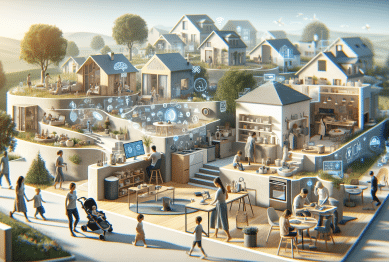Explore how smart home technology can reshape routines, save energy, and offer convenience for all types of households. This guide answers real questions and offers user-focused insights into the latest devices, automation methods, and future trends.
The Basics of Smart Home Technology
Smart home technology has moved far beyond novelty. Now, integrated devices connect lights, appliances, and security systems for easy remote management and automation. Using a smartphone, tablet, or voice assistant, it’s possible to control daily routines, making life feel both smoother and more secure. As people learn about connected homes, energy management, and safer living, many are curious about where to begin. Manufacturers now focus on making the experience simple enough that anyone can participate, even those with limited technical skills. Intuitive apps, compatibility with popular devices, and a growing ecosystem of options drive interest across age groups. The demand for smart devices such as thermostats, smart lights, and security cameras rises every season, reflecting a global fascination with connected living spaces.
One appeal of smart home technology is flexibility. Homeowners can start small with one device, like a smart plug or bulb, and gradually expand their system. Interconnectedness allows users to build an ecosystem tailored to their needs. This flexibility often leads people to ask: how do these elements work together? The answer lies in wireless communication protocols such as Wi-Fi, Zigbee, and Z-Wave, which link devices and share instructions. Growing adoption of smart assistants helps coordinate all these actions, making multitasking at home seamless and hands-free. These technologies also offer the benefit of energy monitoring and waste reduction. By tracking usage patterns, people gain insight into new ways to lower expenses and care for the environment. Households are realizing the value in proactive energy management, which makes this field extremely relevant today.
For those considering smart technology, privacy and security are common concerns. Modern systems have robust safeguards like encrypted communication, regular firmware updates, and customizable privacy controls. However, users should always read policies carefully. At its core, smart home technology aims to make everyday life more comfortable and efficient. From scheduling lights to adjusting thermostats and monitoring for leaks or unexpected guests, convenience is only the beginning. Many people are surprised by how quickly smart home elements become essential in daily routines, especially when integrated with voice commands and automated routines. The modern home is evolving, one connected device at a time.
Popular Devices and What They Offer
Smart thermostats, lights, locks, and cameras are among the most widely adopted devices in smart homes. A smart thermostat can detect occupancy or adjust temperatures based on your habits, helping save energy while keeping homes comfortable. Security is another key interest: video-enabled doorbells, wireless cameras, and smart locks offer real-time notifications and remote access, letting users oversee their property from virtually anywhere. These devices contribute to a safer and more informed home environment, increasing peace of mind even when away. Automated lighting systems are also in high demand. They allow users to change colors, adjust brightness, or set schedules using their voice or mobile device. Over time, these systems adapt to routines, ensuring lights are on when needed and saving power when not in use. Smart plugs and appliances fill in the gaps, making it possible to turn ordinary electronics into intelligent, connected tools. Many are surprised by the versatility—everything from coffee makers to fans can be controlled remotely, automated, and optimized. This accessibility is making high-tech living more attainable for everyone.
The rise of voice assistants, such as Amazon Alexa, Google Assistant, and Apple’s Siri, has contributed to the popularity of smart home gadgets. These digital helpers serve as central hubs, enabling simple voice commands to manage music, climate, news, or even shopping lists. Families, students, and busy professionals rely on these assistants to streamline multitasking and coordinate their devices. Interoperability is a growing trend, with more manufacturers focusing on cross-platform compatibility. This means smarter homes will waste less time with setup, offering a more unified experience. With the proliferation of sensors and machine learning, smart devices are becoming proactive. For instance, a smoke detector might alert an absent homeowner by phone while automatically shutting off HVAC to slow the spread of smoke. The evolving technology demonstrates how smart homes can adapt intelligently to meet changing circumstances.
For those with disabilities or mobility concerns, smart home technology promises greater independence. Devices with voice control or remote features allow effortless management of tasks that once required physical effort. As these advances reach more markets, they hold promise for aging-in-place solutions and accessible living. With so much innovation, it’s helpful to research reviews, try demo features at local stores, and experiment with basic setups. Keeping an eye on firmware and app updates ensures devices continue to operate smoothly and safely. The combination of convenience, security, and inclusivity broadens the appeal of smart technology—some households simply start with what matters most and expand as comfort grows.
Automation and Customization in Connected Homes
Automation is one of the most attractive features of smart homes. By programming routines or ‘scenes,’ people coordinate multiple actions with a single command or detected trigger. For example, setting a bedtime routine might dim lights, lock doors, and lower the thermostat—all at once. Automations can also adapt based on daily schedules, weather, or occupancy sensors. These possibilities help reduce wasted energy and improve comfort. Customized alerts bring peace of mind. Some families program cameras to send notifications only when an unfamiliar person is detected. Door sensors can integrate with lights so hallways gently glow if someone moves at night. Smart technology allows users to create conditions that fit their lives, not the other way around. Flexibility remains a recurring theme—it’s possible to change automations with a few taps or through voice command. If routines change, smart systems can quickly respond, offering true adaptability. As technology advances, more affordable devices enter the market, so experimenting with setups has become much easier. New machine learning improvements mean these automations become smarter over time, learning patterns and suggesting optimizations based on real-world use.
The use of geofencing in smart home automation is also growing. By linking device actions to the physical location of a mobile phone, households can activate systems just as someone arrives home or leaves. This enables secure doors, energy-saving thermostats, or even grocery list reminders as needed. Such features make smart homes more responsive to daily routines. Many platforms now offer ‘If This Then That’ (IFTTT) integrations, allowing creative combinations of triggers and actions. For example, a rain sensor could automatically close windows, or a smart fridge could add milk to a shopping list when low supplies are detected. This level of integration inspires homeowners to experiment, and communities online often share useful recipes for automation ideas. As open-source software grows, sharing and developing custom routines will likely become even more accessible. These dynamic integrations demonstrate the versatility of connected home environments—and how technology can support healthier, more organized living spaces.
An often-overlooked aspect of automation is its role in reinforcing safety. Sensors for smoke, carbon monoxide, or water leaks can proactively alert inhabitants and take direct action, like shutting off valves or sending alerts to emergency contacts. Even simple automations—like turning on lights before you enter a room—can reduce accidents. Such proactive safety measures are particularly appealing for large families, those with children, or individuals living alone. As the connected home landscape evolves, expect automation to incorporate even more predictive elements, using data analytics and artificial intelligence to design better systems. These upgrades promise not just comfort, but greater security for all residents.
Energy Savings and Sustainability Benefits
Smart homes are increasingly recognized for their environmental impact. Devices such as smart thermostats, LED lighting, and energy monitors can drastically reduce waste. These tools collect data on consumption, helping households see where energy can be conserved. Even small tweaks, like scheduling lights to turn off automatically, can add up to noticeable savings over time. In addition to lowering bills, many people find satisfaction in knowing their choices contribute positively to sustainability goals. Governments and utilities are beginning to incentivize smart upgrades. Some programs offer rebates for efficient appliances or encourage participation in demand-response schemes, where smart thermostats automatically reduce usage during peak hours. These incentives can help balance the grid, lower emissions, and make the smart home transition more affordable. Studies suggest early adopters benefit from not just cost savings, but also a sense of taking part in a larger movement. Expanding access to these resources remains a focus for both policymakers and activists.
Solar panels and energy storage solutions pair naturally with smart home platforms. By automatically optimizing when to use stored solar power versus drawing from the grid, these systems help further shrink a household’s carbon footprint. Data analysis allows homeowners to adjust behaviors—running appliances at off-peak times, for instance. Smarter water management is another benefit. Systematic leak detection, timed irrigation, and even weather-aware sprinkler adjustments all conserve resources. Transparent dashboards visualize metrics and make it easy to identify wasteful patterns. As households take a more active role in conservation, many develop a new appreciation for sustainable living. This hands-on influence can inspire friends and neighbors to explore similar solutions.
Some critics voice concerns about the embedded energy costs in manufacturing and disposing of smart devices. Manufacturers and environmental watchdogs are increasingly conscious of these impacts. Recycling programs, firmware upgrades, and support for longer device lifespans are steps in the right direction. Smart homes are part of a broader conversation about how technology can support sustainable societies. The next decade will likely see more partnerships between industry and conservation groups, aiming to maximize the positive impact of connected living. For those looking to reduce their environmental footprint, a stepwise approach can offer major benefits—with resources and guidance widely available from conservation groups and energy collectives.
Privacy and Security in a Connected World
Privacy is top-of-mind for most users considering smart home setups. Each connected device represents a potential vulnerability. However, manufacturers have made significant progress in tightening security standards. Modern smart devices use encrypted connections, two-factor authentication, and frequent software updates. Understanding these features is critical for anyone exploring home automation. Many consumers are now better informed about reading privacy agreements and disabling unnecessary data sharing. Still, questions persist about data collection and its possible uses. Minimizing risk involves choosing reputable brands, using strong, unique passwords, updating devices promptly, and occasionally reviewing connected device lists in smart home hubs. This approach maintains a safer, more enjoyable experience, even as device complexity grows. Developers are becoming more transparent about how data is stored and handled, responding to public demands for clarity.
Some households create separate networks just for their smart devices, reducing the risk of a breach disrupting personal or business activities. Regular security audits—checking which devices are online and who has access—provide protection against potential misuse. Cybersecurity experts recommend disabling features that are not used, especially those that involve listening or video software, to further safeguard privacy. Open communication among household members is also vital, helping establish protocols and boundaries for device use. Schools and nonprofits have launched awareness campaigns educating the public about these issues. Such efforts contribute to a general rise in digital literacy and data stewardship for all ages. Security is never foolproof, yet by staying vigilant and proactive, users can enjoy the advantages of smart homes without undue concerns.
Globally, lawmakers and regulatory agencies are catching up with the fast-evolving world of smart devices. New standards emerge regularly, aiming to protect consumers from unfair data practices and set minimum requirements for device security. These efforts may include clearer privacy labeling, required patching schedules, and improved reporting protocols for vulnerabilities. Homeowners now play a significant role in selecting, updating, and configuring their technology with security in mind. Over time, smart home users develop habits that reinforce privacy, from double-checking app permissions to researching security features before new purchases. These lessons are likely to become as routine as locking doors—part of the new normal in an increasingly connected world.
The Future of Smart Homes
The smart home ecosystem is expanding rapidly. Advances in artificial intelligence, edge computing, and wireless communication are expected to make homes more adaptive and responsive. Devices will increasingly predict homeowner needs—turning off unused appliances, adjusting climate, or suggesting grocery lists. Home automation will emphasize not just convenience but deeper integration with health monitoring, elder care, and entertainment. These trends hold promise for fostering independence and supporting new lifestyles. Research groups are actively testing new applications, such as real-time air quality monitoring and predictive maintenance for appliances. Progress in robotics and machine learning will further personalize home experiences. The result: homes that feel truly attentive and supportive.
Industry standards are moving toward greater interoperability, making it easier to mix and match devices from different brands. This should drive down costs and create wider consumer choice. Energy efficiency, privacy, and user-friendliness will remain at the forefront as new products come to market. Environmental applications will also expand—improving resource management, emergency response, and resilience during outages. The concept of the digital twin is gaining traction. With it, smart homes could soon have virtual models to simulate changes and spot issues before they arise. As with all technology, balancing convenience and privacy will be crucial as the field evolves.
Despite these advances, some barriers remain. Not all regions have robust high-speed internet, and digital literacy varies between communities. Equity is a priority—future smart home solutions should address accessibility and affordability. Increasingly, smart home education and support centers are emerging to help bridge gaps. As these resources grow, expect broader adoption and more diverse innovations. The transformation of everyday life is underway, fueled by curiosity, collaboration, and a drive for greater comfort.
References
1. U.S. Department of Energy. (n.d.). Smart Home Systems. Retrieved from https://www.energy.gov/energysaver/smart-home-systems
2. Consumer Reports. (n.d.). How to Set Up a Smart Home. Retrieved from https://www.consumerreports.org/home-garden/smart-home/how-to-set-up-a-smart-home-a1847074150/
3. Center for Sustainable Systems, University of Michigan. (n.d.). U.S. Energy Use Intensity by Sector. Retrieved from https://css.umich.edu/publications/factsheets/energy/us-energy-use-intensity-sector
4. Electronic Frontier Foundation. (n.d.). Security Tips for Smart Home Devices. Retrieved from https://www.eff.org/pages/security-tips-smart-home-devices
5. National Renewable Energy Laboratory. (n.d.). Smart Home Energy Management. Retrieved from https://www.nrel.gov/docs/fy21osti/78419.pdf
6. Pew Research Center. (n.d.). The Internet of Things Connectivity Binge. Retrieved from https://www.pewresearch.org/internet/2017/06/06/the-internet-of-things-connectivity-binge-what-are-the-implications/









